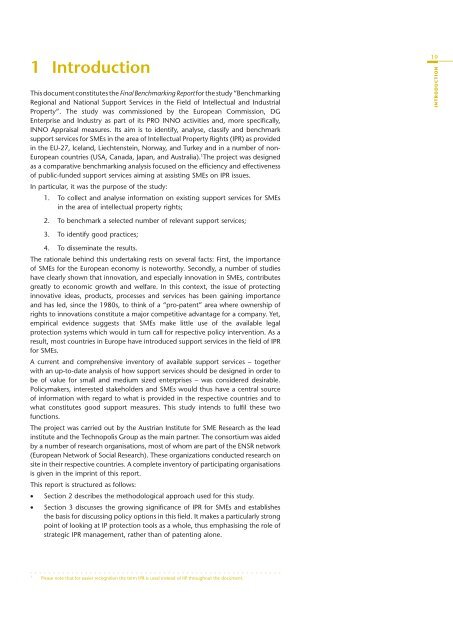Benchmarking National - PRO INNO Europe
Benchmarking National - PRO INNO Europe
Benchmarking National - PRO INNO Europe
Create successful ePaper yourself
Turn your PDF publications into a flip-book with our unique Google optimized e-Paper software.
1 Introduction<br />
This document constitutes the Final <strong>Benchmarking</strong> Report for the study “<strong>Benchmarking</strong><br />
Regional and <strong>National</strong> Support Services in the Field of Intellectual and Industrial<br />
Property”. The study was commissioned by the <strong>Europe</strong>an Commission, DG<br />
Enterprise and Industry as part of its <strong>PRO</strong> <strong>INNO</strong> activities and, more specifically,<br />
<strong>INNO</strong> Appraisal measures. Its aim is to identify, analyse, classify and benchmark<br />
support services for SMEs in the area of Intellectual Property Rights (IPR) as provided<br />
in the EU-27, Iceland, Liechtenstein, Norway, and Turkey and in a number of non-<br />
<strong>Europe</strong>an countries (USA, Canada, Japan, and Australia). 1The project was designed<br />
as a comparative benchmarking analysis focused on the efficiency and effectiveness<br />
of public-funded support services aiming at assisting SMEs on IPR issues.<br />
In particular, it was the purpose of the study:<br />
1. To collect and analyse information on existing support services for SMEs<br />
in the area of intellectual property rights;<br />
2. To benchmark a selected number of relevant support services;<br />
3. To identify good practices;<br />
4. To disseminate the results.<br />
The rationale behind this undertaking rests on several facts: First, the importance<br />
of SMEs for the <strong>Europe</strong>an economy is noteworthy. Secondly, a number of studies<br />
have clearly shown that innovation, and especially innovation in SMEs, contributes<br />
greatly to economic growth and welfare. In this context, the issue of protecting<br />
innovative ideas, products, processes and services has been gaining importance<br />
and has led, since the 1980s, to think of a “pro-patent” area where ownership of<br />
rights to innovations constitute a major competitive advantage for a company. Yet,<br />
empirical evidence suggests that SMEs make little use of the available legal<br />
protection systems which would in turn call for respective policy intervention. As a<br />
result, most countries in <strong>Europe</strong> have introduced support services in the field of IPR<br />
for SMEs.<br />
A current and comprehensive inventory of available support services – together<br />
with an up-to-date analysis of how support services should be designed in order to<br />
be of value for small and medium sized enterprises – was considered desirable.<br />
Policymakers, interested stakeholders and SMEs would thus have a central source<br />
of information with regard to what is provided in the respective countries and to<br />
what constitutes good support measures. This study intends to fulfil these two<br />
functions.<br />
The project was carried out by the Austrian Institute for SME Research as the lead<br />
institute and the Technopolis Group as the main partner. The consortium was aided<br />
by a number of research organisations, most of whom are part of the ENSR network<br />
(<strong>Europe</strong>an Network of Social Research). These organizations conducted research on<br />
site in their respective countries. A complete inventory of participating organisations<br />
is given in the imprint of this report.<br />
This report is structured as follows:<br />
� Section 2 describes the methodological approach used for this study.<br />
� Section 3 discusses the growing significance of IPR for SMEs and establishes<br />
the basis for discussing policy options in this field. It makes a particularly strong<br />
point of looking at IP protection tools as a whole, thus emphasising the role of<br />
strategic IPR management, rather than of patenting alone.<br />
1 Please note that for easier recognition the term IPR is used instead of IIP throughout the document.<br />
19<br />
INTRODUCTION
















